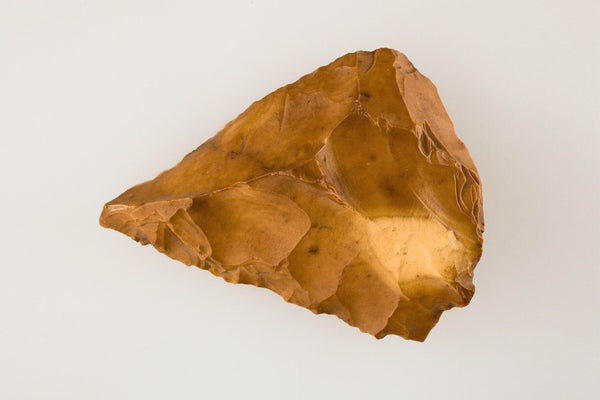Humans Started Passing Down Knowledge to Future Generations 600,000 Years Ago
The advent of “cumulative culture”—teaching others and passing down that knowledge—may have reached an inflection point around the time Neandertals and modern humans split from a common ancestor

MET/BOT/Alamy Stock Photo
Researchers long thought that the ability to utilize tools or share cultural practices set humans apart. But the animal kingdom has provided plenty of examples to the contrary, whether it be stick-wielding pigs, puzzle-solving bumblebees or societies of sperm whales that “chat” with different dialects.
Our species is still unique when it comes to retaining know-how. Over generations of trial and error, humans fine-tuned knowledge and innovations to learn how to craft spear points and make wheels—and all that followed the latter, from oxcarts to Teslas. Learning from past breakthroughs allowed humans to share knowledge and pass it along to future generations, creating a cumulative culture that became a key asset in our species’ evolution. “Our complex and diverse cultural traditions are likely a big part of why humans have been so successful at expanding into areas like the Arctic tundra [or] tropical rainforests and developing cultural adaptations to thrive in them,” says Jonathan Paige, an archaeologist at the University of Missouri, who studies cultural evolution.
Pinpointing when exactly humans began accumulating cultural insights has proven tricky because anthropologists cannot directly observe the social interactions and cultural practices of ancient humans. So Paige recently turned to stone tools as a proxy to understand when humans began building on what they learned. In a paper published today in the journal Proceedings of the National Academy of Sciences USA, Paige and his team conclude that hominins were utilizing a cumulative culture by the Middle Pleistocene some 600,000 years ago.
On supporting science journalism
If you’re enjoying this article, consider supporting our award-winning journalism by subscribing. By purchasing a subscription you are helping to ensure the future of impactful stories about the discoveries and ideas shaping our world today.
Humans and closely related hominins have been creating stone tools for millions of years. But not all ancient tools are created equally. Some are simple instruments, such as two-million-year-old Oldowan pebble tools, stones that are chipped in only two directions. Other tools are far more complex and specialized contraptions, such as Polynesian quadrangular adzes, multifaceted stone blades used by ancient Hawaiians to cut wood.
Paige and his team sifted through the scientific literature to find dozens of examples of stone artifacts created by hominins over the past 3.3 million years. To compare the complexity of the various tools, the team counted up the procedural units it took to make each device. Paige compares these procedural units to steps in a recipe. “Recipes with many steps are more complex than recipes with only a few steps,” he says. Some, such as a 2.6-million-year-old sharpened flake of rock from Ethiopia, took only three steps to make. Others, such as a fine-tuned blade created in Finland around 10,000 years ago, took 19 different steps. The team compared the complexity of the ancient tools with a baseline of stone tools that were created without a cumulative culture. This baseline included devices that were fashioned by modern nonhuman apes and ones that were produced in experiments in which humans crafted flints without prior experience.
The results revealed that hominin toolmaking largely fell into three distinct eras. The oldest tools, fashioned between 3.3 million and 1.8 million years ago, took between only two and four steps to create. Tools then became slightly more complex, averaging around four to seven steps until around 600,000 years ago. The output of this middle period was on par with the complexity of tools produced by nonhuman apes, naive humans and random flaking experiments, which usually took between one and six steps.
Around 600,000 years ago, during the Middle Pleistocene, the pace of change sped up and stone tools became far more complex. Many of the devices from the time took more than 10 steps to complete. By around 300,000 years ago, hominins were creating technology that was twice as complex as the rudimentary tools fashioned by modern chimpanzees to hammer open items such as nuts. The researchers posit that this spike in complexity relates to the origin of a cumulative culture in which ancient hominins retained and expanded upon knowledge of prior stone tools.
Dating cumulative culture back to the Middle Pleistocene aligns with previous estimates, according to anthropologist Alex Mesoudi, who studies cultural evolution at the University of Exeter in England and was not involved in the new paper. But Mesoudi thinks it is possible that other organic elements of cumulative culture, such as wooden structures, ropes or nets, may date back even further. “It’s possible that these emerged earlier [than 600,000 years ago], but we wouldn’t know because they left no trace in the archaeological record,” he says.
The timing makes it likely that other species of hominins also passed cultural insights on to future generations. According to the new paper, the origins of cumulative culture may predate the divergence of Homo sapiens and Neandertals. This is supported by the overlap in complexity seen in the two species’ technology. During the Pleistocene, Neandertals created tools that took between nine and 13 steps. And some Neanderthal technology even outpaced human-made tools during the Middle Pleistocene. For example, Neandertals produced multifaceted spearheads by breaking several flakes off of a stone core. Known as Levallois points, these sharpened instruments are more complex than the blades humans made around the same time.
Cumulative culture also may have originated with the beginnings of language among ancient humans. “It might suggest that language is necessary for cumulative culture in the technological realm … or that language and cumulative technology coevolved together,” Mesoudi says. “This fits some suggestions that grammatical language and complex toolmaking share similar cognitive processes.”
